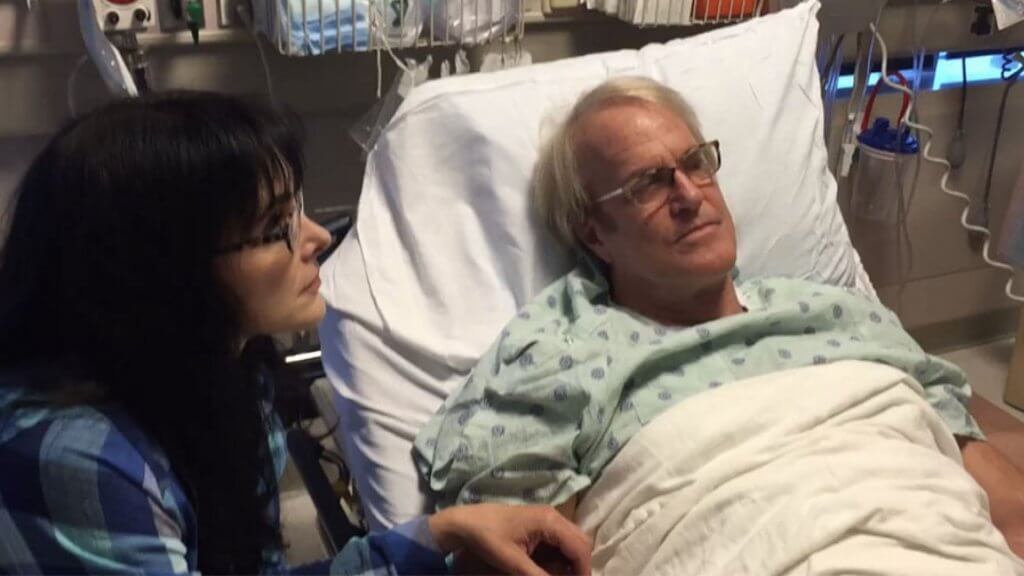Hope Through Advanced Stage Cancer
- Former ‘Entertainment Tonight’ host John Tesh refused to give in to his prognosis after an aggressive prostate cancer diagnosis in 2015. Though he achieved remission, the disease returned in 2020, and after many more challenges, he thankfully defied the odds and achieved remission again.
- Tesh, now 71, faced emotional challenges on top of his physical health and fell into some addictive patterns to cope. The nine-year survivor credits his wife, Connie Sellecca, with helping him through his journey and getting him back on track after his diagnosis.
- Though treatment varies depending on your current health status and how aggressive the cancer appears, recent advancements in the treatment of late-stage prostate cancer are giving new hope to patients.
Tesh, 71, is a nine-year survivor today, and has learned a lot about perspective through both of his advanced stage cancer diagnoses. He now looks at life and the scope of his health challenges in a more positive way, as noted on social media by non-profit organization My Faulty Gene who highlighted Tesh’s journey on Thursday.
Read MoreView this post on Instagram
The former Entertainment Tonight host, who lost his father to cancer, came forward to PEOPLE in 2021, sharing that his prostate cancer recurred the year before at the height of the pandemic. He had been battling privately for a year.
“I woke up with an enormous amount of pain one morning in October 2020 I had pain in both my legs,” Tesh said. “It turned out there were two tumors around either side of my pelvis and wrapped around my organs.”
“I went back into the trenches I was battle-ready,” Tesh continued to the outlet. “I felt less like a guy who was sick trying to get well and more like somebody who was healed well resisting sickness.”
In Remission from Prostate Cancer
After several surgeries, chemotherapy, and a prostatectomy, which is the surgical removal of all or part of the prostate, Tesh again went into remission, though he said he only has one functional kidney after all he endured.
Tesh credited his wife, Connie Sellecca, with helping him through his journey and getting him back on track after his first diagnosis.
At the time, doctors told Tesh he had 18 months to live. “It was a get-your-affairs-in-order speech,” said Tesh.

“Ultimately, my wife and I went toe-to-toe, and she said, ‘I am not going to abide this. This is my battle too. And you’re giving up,’” Tesh recalled. “If she hadn’t been my advocate and such a brilliant study of prostate cancer, I wouldn’t have made it.”
That mentality stayed with Tesh and allowed him to take swift and life-saving action when his cancer came back.
“This is a couple’s disease; it affects the whole family,” Tesh shared. “We made it clear to our doctors that if there were couples going through this battle, especially with prostate cancer, here’s our phone number. Because prostate cancer breaks up marriages, it breaks up relationships. People can’t take it, it freaks them out.”
Feelings of Anger During Cancer
The versatile entertainer says that he used to be angry, and took it out on his partner.
“I was angry at God. I was angry at everybody,” he said. “And for some reason, I was angry at my wife.”
Managing Fear After a Prostate Cancer Diagnosis
Continued Tesh, “I was drinking too much Scotch whiskey. When you get a cancer diagnosis like this, you become very popular and people are whispering around you and you can get anything. You can get Vicodin if you want. You can drink as much as you want and you can just feel sorry for yourself as much as you want.”
Tesh said he almost lost his wife, who he married in 1992, because he walked out.

“I walked out of the house, and I went on a bicycle journey to try and figure myself out. Fortunately, she forgave me because that was nothing more than disrespect to her because she had been working so hard as an advocate. Feeling sorry for yourself will also get you killed.”
How to Treat Late-Stage Prostate Cancer: New Treatment Developments
Advancements in the treatment of late-stage prostate cancer are giving new hope to patients.
Treatment of late-stage prostate cancer, also called metastatic or stage 4 prostate cancer, varies depending on your current health status and how aggressive the cancer appears.
But new treatment advancements such as PARP inhibitors and new androgen deprivation drugs are making more options available.
According to Dr. Jeff Tosoian, a urologic oncologist at Vanderbilt University Medical Center, there are two primary situations in which you may be diagnosed with late-stage prostate cancer:
- There are those who have been treated for local prostate cancer and it recurs and spreads to other areas.
- “Or there are folks who never knew they had a localized prostate cancer and present with cancer, both in the prostate and in other places in the body,” Tosoian says.
At this stage of the disease process, some treatments may be palliative, meaning they are designed to help relieve symptoms rather than curative therapies designed to stop or slow cancer growth.
And while there is no known curative treatment available for stage 4 prostate cancer, there are many drugs being investigated in clinical trials of prostate cancer patients with late-stage disease. These treatments will likely play a role in the future management of metastatic prostate cancer.
Targeted Therapy
Targeted therapy is a developing treatment option for prostate cancer. Unlike cytotoxic chemotherapy, which damages healthy cells, targeted therapies interfere with specific molecular pathways.
These drugs can target and destroy specific cancer cells with fewer side effects than traditional chemotherapy.
Targeted therapy has three major mechanisms of action:
- Blocking the growth factor that encourages tumor cells to grow
- Interfering with the synthesis or function of DNA
- Disrupting cell signaling pathways essential for the survival and growth of cancer cells
PARP Inhibitors
PARP inhibitors work to stop the activity of poly (ADP-ribose) polymerase, a protein involved in DNA repair.
In normal cells, PARP quickly repairs damaged DNA. In cancer cells, defective DNA cannot be repaired effectively when a patient is undergoing treatment without a PARP inhibitor.
Without PARP to fix them, these breaks accumulate and cause cell death. Without PARP to fix breaks in DNA, DNA damage accumulates within cancer cells and causes cell death.
There are currently two FDA-approved PARP inhibitors to treat metastatic castration-resistant prostate cancer, which include:
Lynparza (olaparib):
A twice-daily oral pill given in combination with a gonadotropin-releasing hormone (GnRH)unless a bilateral orchiectomy (surgery to remove both testicles) has been done.
The most common side effects include nausea, vomiting, fatigue, headaches, low white blood cell count, low red blood cell count (anemia), dizziness, and diarrhea.
Rubraca (rucaparib):
- A twice-daily oral pill taken with or without food.
- Like Lynparza, Rubraca is given in combination with a gonadotropin-releasing hormone (GnRH)unless a bilateral orchiectomy (surgery to remove both testicles) has been done.
- Some of the most common side effects include nausea, vomiting, fatigue, low red blood cell count (anemia), abdominal pain, changes in bowel habits, and low platelets.
A 2021 study showed a positive result using combination therapy involving Lynparza (Olaparib) and an immunotherapy drug, Keytruda (pembrolizumab). While this is not an approved treatment at this time, it is a good example of new treatment options being developed.
Keytruda (pembrolizumab) and Lynparza (olaparib) combination therapy:
- Current trials investigating this drug combination for metastatic castration-resistant prostate cancer (mCRPC) show promising results, including a 58.6% reduction in target lesion size. Common side effects include anemia, nausea, fatigue, and loss of appetite.
Hormone Therapy
Hormone therapy is used when patients are unable to have cancer surgically removed because it has spread to other parts of the body.
Although hormone therapies do not cure stage 4 prostate cancer, they may help keep it from growing and spreading further.
“The traditional standard of care for metastatic prostate cancer is androgen deprivation therapy, or hormone therapy,” Dr. Tosoian explained.
Androgen deprivation therapy is a type of hormone therapy that works by inhibiting androgen production, including testosterone, or blocking androgen receptors which can slow down tumor growth.
“Prostate cancer feeds off testosterone,” Dr. Mark K. O’Keeffe previously told SurvivorNet. “When you lower testosterone with androgen deprivation therapy, it’s no longer feeding the cancer.”
As metastatic prostate cancer progresses, the cancer cells can adapt and become resistant to therapy.
According to Dr. O’Keeffe, this is true for most cancer treatments. “You have some men that are on it for many years and some men can progress in less than a year if they have a more aggressive type of cancer.”
Two newer androgen deprivation therapies for late-stage prostate cancer include:
Xtandi (enzalutamide):
- FDA-approved to treat non-metastatic (nmCRPC) and metastatic castration-resistant prostate cancer (mCRPC) and metastatic castration-sensitive prostate cancer (mCSPC).
- It’s a once-daily oral pill that can be taken with or without food.
- The most common side effects include fatigue, weakness, hot flashes, back pain, joint pain, changes in bowel habits, high blood pressure (hypertension), and decreased appetite.
Erleada (apalutamide):
- FDA-approved to treat metastatic castrate-sensitive prostate cancer (mCRPC).
It’s a once-daily pill taken by mouth. - The most common side effects include rash, hot flashes, high blood pressure, itching, and joint pain.
Bone Therapy
- Metastatic cancer can destroy bone tissue and release substances that cause additional bone damage.
Doctors often manage bone loss with treatment to stop or slow bone destruction (such as bisphosphonate drugs), reduce pain, and prevent fractures.
New drugs available to prevent bone loss and fractures in those whose cancer has already spread to the bones include:
- Xgeva (denosumab):
- FDA-approved for preventing skeletal complications in men with advanced prostate cancer who are at high risk for fracture.
It’s an injection given under the skin every four weeks. - The most common side effects include shortness of breath, fatigue, nausea, and low phosphate levels in your blood.
Other Treatment Options
Depending on the extent of disease, a person with late-stage prostate cancer will likely undergo some combination of treatments. Your care team might include doctors from different specialties, surgeons, medical oncologists, radiation oncologists, and nurses.
Other treatment options may include:
- Chemo: The goal of this therapy is not to cure prostate cancer, but rather to slow its growth and reduce symptoms.
- Radiation Therapy: This therapy uses high-energy rays or particles that are focused on prostate cancer cells to damage or destroy them. This treatment is effective for helping to ease symptoms related to prostate cancer, but it’s not used as a cure.
- Surgery: Surgery isn’t common in late-stage prostate cancer. However, sometimes, doctors may surgically remove the testicles (called an orchiectomy or surgical castration) in order to stop the production of testosterone.
- Clinical trials: Clinical trials are being conducted for many types of advanced prostate cancer. Participation may give you access to new drugs and treatments.
- Cancer vaccine: Provenge, an immunotherapy treatment given over the course of one month, is the first FDA-approved vaccine for metastatic castration-resistant prostate cancer (mCRPC). It helps your immune system attack prostate cancer cells that have been growing and dividing throughout the body. Common side effects include fatigue, chills, fever, back pain, nausea, joint pain, and headaches.
Discuss Treatment Options With Your Doctor
Although stage 4 prostate cancer isn’t considered curable, new treatment options are prolonging life and delaying the progression of the disease. With the latest therapies, many can live for years past diagnosis.
Discuss your treatment options with your care team and family. It’s important to understand what treatments are available, how they work, and what to expect.
Your doctor will tailor your therapy to meet your specific needs and discuss the benefits, risks, and side effects of each therapy.
Learn more about SurvivorNet's rigorous medical review process.

